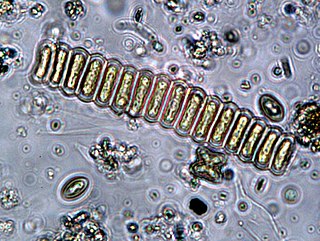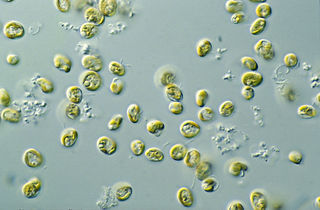Related Research Articles

Biofuel is a fuel that is produced over a short time span from biomass, rather than by the very slow natural processes involved in the formation of fossil fuels, such as oil. Biofuel can be produced from plants or from agricultural, domestic or industrial biowaste. The climate change mitigation potential of biofuel varies considerably, from emission levels comparable to fossil fuels in some scenarios to negative emissions in others. Biofuels are mostly used for transportation, but can also be used for heating and electricity. Biofuels are regarded as a renewable energy source.

Biodiesel is a form of diesel fuel derived from plants or animals and consisting of long-chain fatty acid esters. It is typically made by chemically reacting lipids such as animal fat (tallow), soybean oil, or some other vegetable oil with an alcohol, producing a methyl, ethyl or propyl ester by the process of transesterification.
The Aquatic Species Program was a research program in the United States launched in 1978 by President Jimmy Carter and was funded by the United States Department of Energy, which over the course of nearly two decades looked into the production of energy using algae. Initially, the funding of the Aquatic Species Program was to develop renewable fuel for transportation. Later, the program focused on producing bio-diesel from algae. The research program was discontinued in 1996. The research staff compiled their work and conclusions into a 1998 report.
Pyrolysis oil, sometimes also known as bio-crude or bio-oil, is a synthetic fuel under investigation as substitute for petroleum. It is obtained by heating dried biomass without oxygen in a reactor at a temperature of about 500 °C (900 °F) with subsequent cooling. Pyrolysis oil is a kind of tar and normally contains levels of oxygen too high to be considered a pure hydrocarbon. This high oxygen content results in non-volatility, corrosiveness, immiscibility with fossil fuels, thermal instability, and a tendency to polymerize when exposed to air. As such, it is distinctly different from petroleum products. Removing oxygen from bio-oil or nitrogen from algal bio-oil is known as upgrading.
The United States produces mainly biodiesel and ethanol fuel, which uses corn as the main feedstock. The US is the world's largest producer of ethanol, having produced nearly 16 billion gallons in 2017 alone. The United States, together with Brazil accounted for 85 percent of all ethanol production, with total world production of 27.05 billion gallons. Biodiesel is commercially available in most oilseed-producing states. As of 2005, it was somewhat more expensive than fossil diesel, though it is still commonly produced in relatively small quantities.

Botryococcus braunii is a green, pyramid-shaped planktonic microalga that is of potentially great importance in the field of biotechnology. Colonies held together by a lipid biofilm matrix can be found in temperate or tropical oligotrophic lakes and estuaries, and will bloom when in the presence of elevated levels of dissolved inorganic phosphorus. The species is notable for its ability to produce high amounts of hydrocarbons, especially oils in the form of Triterpenes, that are typically around 30–40% of their dry weight. Compared to other green alge species it has a relatively thick cell wall that is accumulated from previous cellular divisions; making extraction of cytoplasmic components rather difficult. Much of the useful hydrocarbon oil is outside of the cell.
Biofuel is fuel that is produced from organic matter (biomass), including plant materials and animal waste. It is considered a renewable source of energy that can assist in reducing carbon emissions. The two main types of biofuel currently being produced in Australia are biodiesel and bioethanol, used as replacements for diesel and petrol (gasoline) respectively. As of 2017 Australia is a relatively small producer of biofuels, accounting for 0.2% of world bioethanol production and 0.1% of world biodiesel production.

Vegetable oils are increasingly used as a substitute for fossil fuels. Vegetable oils are the basis of biodiesel, which can be used like conventional diesel. Some vegetable oil blends are used in unmodified vehicles, but straight vegetable oil often needs specially prepared vehicles which have a method of heating the oil to reduce its viscosity and surface tension, sometimes specially made injector nozzles, increased injection pressure and stronger glow-plugs, in addition to fuel pre-heating is used. Another alternative is vegetable oil refining.

Scenedesmus is a genus of green algae, in the class Chlorophyceae. They are colonial and non-motile.
Second-generation biofuels, also known as advanced biofuels, are fuels that can be manufactured from various types of non-food biomass. Biomass in this context means plant materials and animal waste used especially as a source of fuel.
Auxenochlorella protothecoides, formerly known as Chlorella protothecoides, is a facultative heterotrophic green alga in the family Chlorellaceae. It is known for its potential application in biofuel production. It was first characterized as a distinct algal species in 1965, and has since been regarded as a separate genus from Chlorella due its need for thiamine for growth. Auxenochlorella species have been found in a wide variety of environments from acidic volcanic soil in Italy to the sap of poplar trees in the forests of Germany. Its use in industrial processes has been studied, as the high lipid content of the alga during heterotrophic growth is promising for biodiesel; its use in wastewater treatment has been investigated, as well.
Choricystis is a genus of green algae in the class Trebouxiophyceae, considered a characteristic picophytoplankton in freshwater ecosystems. Choricystis, especially the type species Choricystis minor, has been proposed as an effective source of fatty acids for biofuels. Choricystis algacultures have been shown to survive on wastewater. In particular, Choricystis has been proposed as a biological water treatment system for industrial waste produced by the processing of dairy goods.
China has set the goal of attaining one percent of its renewable energy generation through bioenergy in 2020.

Algae fuel, algal biofuel, or algal oil is an alternative to liquid fossil fuels that uses algae as its source of energy-rich oils. Also, algae fuels are an alternative to commonly known biofuel sources, such as corn and sugarcane. When made from seaweed (macroalgae) it can be known as seaweed fuel or seaweed oil.

Cellana, Inc. is an American company which develops of algae-based bioproducts for high-value nutrition, ink, and bioenergy applications, including Omega-3 nutraceutical applications, sustainable ink, aquaculture and animal feeds, human food ingredients, pigments, specialty chemicals, and biofuels. The company, with offices in Hawaii and San Diego, has received multiple multimillion-dollar grants from the United States Department of Energy and United States Department of Agriculture.

The use of biofuels varies by region. The world leaders in biofuel development and use are Brazil, United States, France, Sweden and Germany.

An algae bioreactor is used for cultivating micro or macro algae. Algae may be cultivated for the purposes of biomass production (as in a seaweed cultivator), wastewater treatment, CO2 fixation, or aquarium/pond filtration in the form of an algae scrubber. Algae bioreactors vary widely in design, falling broadly into two categories: open reactors and enclosed reactors. Open reactors are exposed to the atmosphere while enclosed reactors, also commonly called photobioreactors, are isolated to varying extents from the atmosphere. Specifically, algae bioreactors can be used to produce fuels such as biodiesel and bioethanol, to generate animal feed, or to reduce pollutants such as NOx and CO2 in flue gases of power plants. Fundamentally, this kind of bioreactor is based on the photosynthetic reaction, which is performed by the chlorophyll-containing algae itself using dissolved carbon dioxide and sunlight energy. The carbon dioxide is dispersed into the reactor fluid to make it accessible for the algae. The bioreactor has to be made out of transparent material.
United States policy in regard to biofuels, such as ethanol fuel and biodiesel, began in the early 1990s as the government began looking more intensely at biofuels as a way to reduce dependence on foreign oil and increase the nation's overall sustainability. Since then, biofuel policies have been refined, focused on getting the most efficient fuels commercially available, creating fuels that can compete with petroleum-based fuels, and ensuring that the agricultural industry can support and sustain the use of biofuels.
References
- 1 2 Gallinaro, Delia (2014). "American funding for biofuel/biorefinery research & development". Environmental Biotechnology. 10 (1): 23–25. doi: 10.14799/ebms243 .
- ↑ "Bioenergy Technologies Office Multi-Year Program Plan: March 2016 | Department of Energy". energy.gov. Retrieved 2016-11-14.
- ↑ "Algal Biofuels | Department of Energy". energy.gov. Retrieved 2016-11-14.
- ↑ Louw, T.M.; Griffiths, M.J.; Jones, S.M.J.; Harison, S.T.L. (2016). "Techno-economics of algal biodiesel". In Bux, F.; Christi, Y. (eds.). Algae Biotechnology: Products and Processes. Springer International Publishing Switzerland. p. 114.
- ↑ Nagarajan, Sanjay; Chou, Siaw Kiang; Cao, Shenyan; Wu, Chen; Zhou, Zhi (2012-12-05). "An updated comprehensive techno-economic analysis of algae biodiesel". Bioresource Technology. 145: 150–156. doi:10.1016/j.biortech.2012.11.108. ISSN 0960-8524. PMID 23260269.
- ↑ Gold, Russell (2009-04-11). "Pond Scum Gets Its Moment in the Limelight". The Wall Street Journal.
- ↑ "Office of Research". Archived from the original on 2009-10-19. Retrieved 2009-09-30.
- ↑ "Algae CO2 Capture Part 1: How it Works | reveal.uky.edu". reveal.uky.edu. Archived from the original on 2015-06-03. Retrieved 2015-06-02.
- ↑ Crocker, Mark (March 21, 2014). "CO2 Recycling using Microalgae for the Production of Fuels". Applied Petrochemical Research. 4: 41–53. doi: 10.1007/s13203-014-0052-3 .
- ↑ Santillan-Jimenez, Eduardo; Morgan, Tonya; Shoup, Jaime; Harman-Ware, Anne E.; Crocker, Mark (2014). "Catalytic deoxygenation of triglycerides and fatty acids to hydrocarbons over Ni–Al layered double hydroxide". Catalysis Today. 237: 136–144. doi:10.1016/j.cattod.2013.11.009 . Retrieved 2015-06-08.
- ↑ "Biofuels from industrial/domestic wastewater". Archived from the original on 2009-02-18. Retrieved 2008-06-11.
- ↑ Senthil Chinnasamy; K. C. Das. "Microalgal Biomass Production Using Industrial Wastewater" (PDF). University of Georgia. Retrieved 30 May 2023.
- ↑ "Algaewheel — Wastewater Treatment Specialists". Archived from the original on 30 May 2008. Retrieved 2008-06-18.
- ↑ "Indiana Company to Submit Proposal to Utilize Algae to Treat Wastewater and Create Renewable Energy". E-Wire. 2008-06-12. Archived from the original on 2012-07-31. Retrieved 2008-06-18.